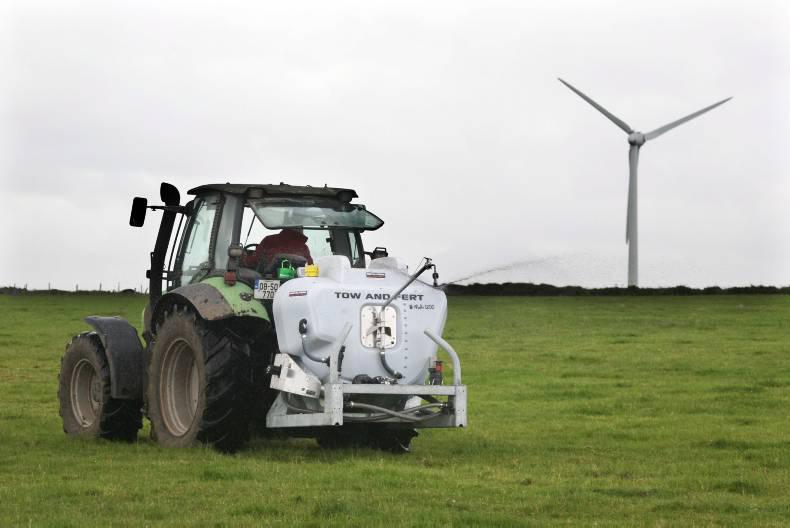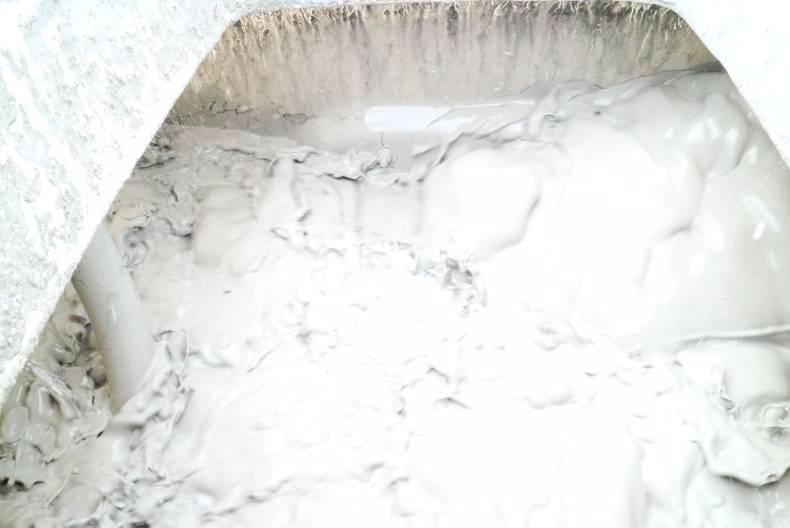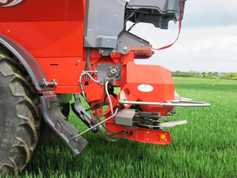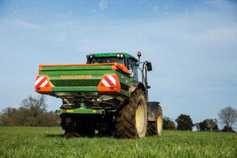Reseeding is important in keeping grass production high and maximising output from each hectare of land. However, for the majority of lowly stocked farmers, before they look at reseeding, correcting soil pH will probably give the largest and fastest improvement on the farm in terms of grass production and quality.
The traditional method of using ground limestone to increase soil pH continues to be the norm across the country.
However, for those in high rainfall areas, complications of small fields, managing grass covers and battling with wet conditions makes applying lime to grass swards and reseeds difficult. In recent years, products such as granular lime have made a significant difference to farmers on heavy land, allowing them to correct soil acidity quickly without the use of very heavy machinery. However, this form of lime application is more costly than the conventional application of ground limestone.
Liquid lime – a new option
New Zealand-based company Tow and Farm has launched a new lime applicator in Ireland. The product was designed in New Zealand about nine years ago and machines have been sold in New Zealand, Australia and Japan so far. The company recently started to demonstrate the method on farms across Ireland. Currently, there is no independent Irish research on the benefits and effects of using this method.
Applying lime and nitrogen
The machine itself looks simple in design, and is made of plastic and stainless-steel products. Feed grade lime is mixed with water in a large tank to form a thick paste. The lime used is ground to a particle size of 100 microns, so very little is required to achieve the same neutralising value of ground lime stone.
New Zealander Tim Henman, one of the engineers who worked on the design of the machine, told the Irish Farmers Journal that when applying lime using this method, they recommend ‘‘the little and often approach’’.
As the lime used is ground so finely, its effect on raising the soil pH is fast, so a quick response is seen at field level. The other main advantage of using this method is that nitrogen can also be applied with the lime solution at the same time.
Fertilisers such as CAN or urea can be mixed with the lime paste and applied directly to fields, allowing farmers to apply fertiliser and lime in one pass.
Tim claims that applying urea with the lime in a liquid form results in fewer losses from volatilisation and leaching, meaning that nitrogen use can be reduced while the same dry matter production can be achieved. This claim is backed up by research, which was conducted at the University of Canterbury, Massey University and Balance Agri Nutrients.
Research comparing urea efficiency, when applied in fine particle form and in granular form, found that applying urea in fine particles or dissolved form resulted in a 48% increase in grass dry matter production per kilo of N applied in that form compared with urea applied in granular form. In addition, there was slightly less leaching when urea was applied in a dissolved form.
Kingshay trial
The New Zealand firm Tow and Fert recently conducted a trial at the Kingshay farm, near Glastonbury in the UK. The trial was conducted over a two-month period.
On 30 April, the first urea application took place and samples were taken and grass grazed on 24 May. The second application took place on 31 May and samples were again taken and grass grazed on 21 June.
Where urea was put into solution and applied at a rate of 75kg/ha, when compared with the same level applied using granular urea, grass dry matter production was more than 45% higher where urea was applied in aqueous form.
Products such as granular lime have made a significant difference to farmers on heavy land, allowing them to correct soil acidity quickly
Farmers who have done trial plots so far have seen similar grass growth where half the level of nitrogen was applied as urea and the control plot with a “full” rate of either granular urea or CAN. This was done in grazing paddocks on several farms in Mayo/Galway and Sligo with half a paddock as control and the other sprayed with the Tow And Fert machine.
Fine particle lime was included with the urea for paddocks where pH needed to be increased. The lift in grass yield in these fields was noticeable within two weeks.
The experience of farmers in New Zealand and Australia has been that even where pH is showing optimum levels, they always get an increase in grass production with a small addition of fine-particle lime to the nitrogen mix. This is put down to correcting surface acidity in the top 2cm of the soil. Most users of the machine in New Zealand add 1kg to 5kg of lime per acre with each application of nitrogen, even where pH is testing OK.
Key points
Tow and Fert has been designed to apply fine-particle lime and nitrogen together at the same time.Studies have shown that higher efficiency can be achieved where urea is applied in liquid form.No independent studies have been conducted in Ireland so far.The cost is expected to be similar to applying ground limestone in the conventional method, but it gives a wider window of application and greater flexibility to correct soil pH levels. Leslie Dwyer, who has secured an agency for the Tow And Fert range in Ireland, said that the company is currently working with McGrath’s of Cong in formulating a product specifically for the Tow And Fert machine.
At a TNV of 115, it includes limestone that is ground five times finer than cubicle lime. This will allow users to achieve the same results with one tonne of this product as they would with 10t of Grolime.
Leslie said that it is aimed at the large-scale farmer or contractor with the aim being to correct soil pH where necessary and then to apply lime with the fertiliser “little and often” to maintain soil pH levels and counteract surface acidity. This has proven to be an effective strategy in New Zealand to maintain soil pH levels on a yearly basis. The machine has a price tag of approximately €19,900 plus VAT.
Tim Henman claimed that by combining nitrogen applications at a half rate with lime and applying it in a little and often approach, there is a cost reduction per kilo of grass dry matter produced. However, the machine itself is costly.
However, as of yet, there is no contractor price available for applying lime with the Tow and Fert spreader, so comparing the cost-effectiveness of using this method when compared with the conventional methods is not yet possible.
Tow and Fert has been designed to apply fine-particle lime and nitrogen together at the same time.Studies have shown that higher efficiency can be achieved where urea is applied in liquid form.No independent studies have been conducted in Ireland so far.The cost is expected to be similar to applying ground limestone in the conventional method, but it gives a wider window of application and greater flexibility to correct soil pH levels. Read more
Focus: Reseeding and feed options
Reseeding is important in keeping grass production high and maximising output from each hectare of land. However, for the majority of lowly stocked farmers, before they look at reseeding, correcting soil pH will probably give the largest and fastest improvement on the farm in terms of grass production and quality.
The traditional method of using ground limestone to increase soil pH continues to be the norm across the country.
However, for those in high rainfall areas, complications of small fields, managing grass covers and battling with wet conditions makes applying lime to grass swards and reseeds difficult. In recent years, products such as granular lime have made a significant difference to farmers on heavy land, allowing them to correct soil acidity quickly without the use of very heavy machinery. However, this form of lime application is more costly than the conventional application of ground limestone.
Liquid lime – a new option
New Zealand-based company Tow and Farm has launched a new lime applicator in Ireland. The product was designed in New Zealand about nine years ago and machines have been sold in New Zealand, Australia and Japan so far. The company recently started to demonstrate the method on farms across Ireland. Currently, there is no independent Irish research on the benefits and effects of using this method.
Applying lime and nitrogen
The machine itself looks simple in design, and is made of plastic and stainless-steel products. Feed grade lime is mixed with water in a large tank to form a thick paste. The lime used is ground to a particle size of 100 microns, so very little is required to achieve the same neutralising value of ground lime stone.
New Zealander Tim Henman, one of the engineers who worked on the design of the machine, told the Irish Farmers Journal that when applying lime using this method, they recommend ‘‘the little and often approach’’.
As the lime used is ground so finely, its effect on raising the soil pH is fast, so a quick response is seen at field level. The other main advantage of using this method is that nitrogen can also be applied with the lime solution at the same time.
Fertilisers such as CAN or urea can be mixed with the lime paste and applied directly to fields, allowing farmers to apply fertiliser and lime in one pass.
Tim claims that applying urea with the lime in a liquid form results in fewer losses from volatilisation and leaching, meaning that nitrogen use can be reduced while the same dry matter production can be achieved. This claim is backed up by research, which was conducted at the University of Canterbury, Massey University and Balance Agri Nutrients.
Research comparing urea efficiency, when applied in fine particle form and in granular form, found that applying urea in fine particles or dissolved form resulted in a 48% increase in grass dry matter production per kilo of N applied in that form compared with urea applied in granular form. In addition, there was slightly less leaching when urea was applied in a dissolved form.
Kingshay trial
The New Zealand firm Tow and Fert recently conducted a trial at the Kingshay farm, near Glastonbury in the UK. The trial was conducted over a two-month period.
On 30 April, the first urea application took place and samples were taken and grass grazed on 24 May. The second application took place on 31 May and samples were again taken and grass grazed on 21 June.
Where urea was put into solution and applied at a rate of 75kg/ha, when compared with the same level applied using granular urea, grass dry matter production was more than 45% higher where urea was applied in aqueous form.
Products such as granular lime have made a significant difference to farmers on heavy land, allowing them to correct soil acidity quickly
Farmers who have done trial plots so far have seen similar grass growth where half the level of nitrogen was applied as urea and the control plot with a “full” rate of either granular urea or CAN. This was done in grazing paddocks on several farms in Mayo/Galway and Sligo with half a paddock as control and the other sprayed with the Tow And Fert machine.
Fine particle lime was included with the urea for paddocks where pH needed to be increased. The lift in grass yield in these fields was noticeable within two weeks.
The experience of farmers in New Zealand and Australia has been that even where pH is showing optimum levels, they always get an increase in grass production with a small addition of fine-particle lime to the nitrogen mix. This is put down to correcting surface acidity in the top 2cm of the soil. Most users of the machine in New Zealand add 1kg to 5kg of lime per acre with each application of nitrogen, even where pH is testing OK.
Key points
Tow and Fert has been designed to apply fine-particle lime and nitrogen together at the same time.Studies have shown that higher efficiency can be achieved where urea is applied in liquid form.No independent studies have been conducted in Ireland so far.The cost is expected to be similar to applying ground limestone in the conventional method, but it gives a wider window of application and greater flexibility to correct soil pH levels. Leslie Dwyer, who has secured an agency for the Tow And Fert range in Ireland, said that the company is currently working with McGrath’s of Cong in formulating a product specifically for the Tow And Fert machine.
At a TNV of 115, it includes limestone that is ground five times finer than cubicle lime. This will allow users to achieve the same results with one tonne of this product as they would with 10t of Grolime.
Leslie said that it is aimed at the large-scale farmer or contractor with the aim being to correct soil pH where necessary and then to apply lime with the fertiliser “little and often” to maintain soil pH levels and counteract surface acidity. This has proven to be an effective strategy in New Zealand to maintain soil pH levels on a yearly basis. The machine has a price tag of approximately €19,900 plus VAT.
Tim Henman claimed that by combining nitrogen applications at a half rate with lime and applying it in a little and often approach, there is a cost reduction per kilo of grass dry matter produced. However, the machine itself is costly.
However, as of yet, there is no contractor price available for applying lime with the Tow and Fert spreader, so comparing the cost-effectiveness of using this method when compared with the conventional methods is not yet possible.
Tow and Fert has been designed to apply fine-particle lime and nitrogen together at the same time.Studies have shown that higher efficiency can be achieved where urea is applied in liquid form.No independent studies have been conducted in Ireland so far.The cost is expected to be similar to applying ground limestone in the conventional method, but it gives a wider window of application and greater flexibility to correct soil pH levels. Read more
Focus: Reseeding and feed options






 This is a subscriber-only article
This is a subscriber-only article














SHARING OPTIONS: